Court Observation Report at the Supreme Court of Victoria
VerifiedAdded on 2023/03/17
|9
|2286
|60
AI Summary
This court observation report provides a detailed account of the author's experience at the Supreme Court of Victoria, including information on court room setting, criminal and civil procedures, and personal observations. The report also discusses the appellate jurisdiction of the Supreme Court and the difference between the commercial and common law sections of the Trial Division.
Contribute Materials
Your contribution can guide someone’s learning journey. Share your
documents today.
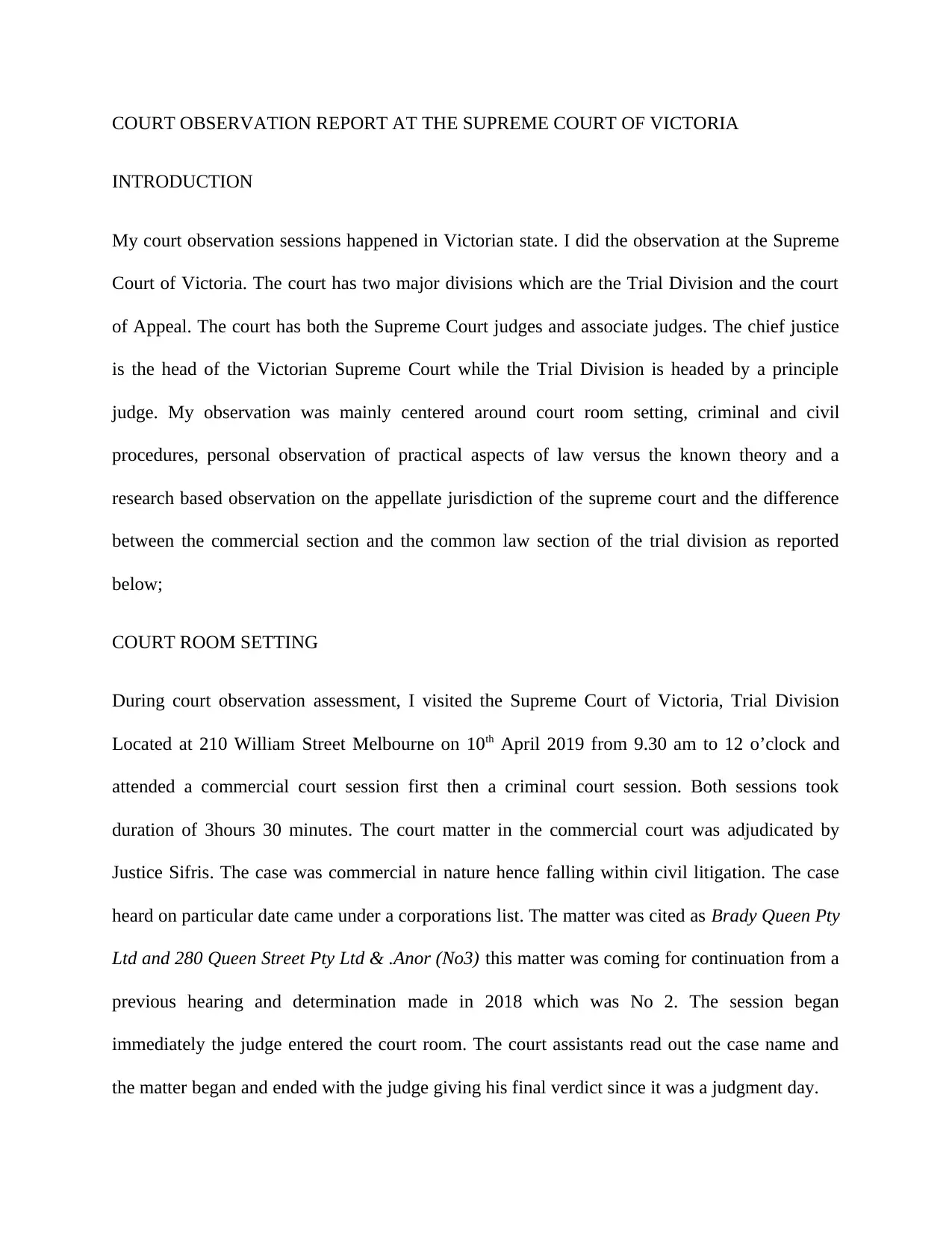
COURT OBSERVATION REPORT AT THE SUPREME COURT OF VICTORIA
INTRODUCTION
My court observation sessions happened in Victorian state. I did the observation at the Supreme
Court of Victoria. The court has two major divisions which are the Trial Division and the court
of Appeal. The court has both the Supreme Court judges and associate judges. The chief justice
is the head of the Victorian Supreme Court while the Trial Division is headed by a principle
judge. My observation was mainly centered around court room setting, criminal and civil
procedures, personal observation of practical aspects of law versus the known theory and a
research based observation on the appellate jurisdiction of the supreme court and the difference
between the commercial section and the common law section of the trial division as reported
below;
COURT ROOM SETTING
During court observation assessment, I visited the Supreme Court of Victoria, Trial Division
Located at 210 William Street Melbourne on 10th April 2019 from 9.30 am to 12 o’clock and
attended a commercial court session first then a criminal court session. Both sessions took
duration of 3hours 30 minutes. The court matter in the commercial court was adjudicated by
Justice Sifris. The case was commercial in nature hence falling within civil litigation. The case
heard on particular date came under a corporations list. The matter was cited as Brady Queen Pty
Ltd and 280 Queen Street Pty Ltd & .Anor (No3) this matter was coming for continuation from a
previous hearing and determination made in 2018 which was No 2. The session began
immediately the judge entered the court room. The court assistants read out the case name and
the matter began and ended with the judge giving his final verdict since it was a judgment day.
INTRODUCTION
My court observation sessions happened in Victorian state. I did the observation at the Supreme
Court of Victoria. The court has two major divisions which are the Trial Division and the court
of Appeal. The court has both the Supreme Court judges and associate judges. The chief justice
is the head of the Victorian Supreme Court while the Trial Division is headed by a principle
judge. My observation was mainly centered around court room setting, criminal and civil
procedures, personal observation of practical aspects of law versus the known theory and a
research based observation on the appellate jurisdiction of the supreme court and the difference
between the commercial section and the common law section of the trial division as reported
below;
COURT ROOM SETTING
During court observation assessment, I visited the Supreme Court of Victoria, Trial Division
Located at 210 William Street Melbourne on 10th April 2019 from 9.30 am to 12 o’clock and
attended a commercial court session first then a criminal court session. Both sessions took
duration of 3hours 30 minutes. The court matter in the commercial court was adjudicated by
Justice Sifris. The case was commercial in nature hence falling within civil litigation. The case
heard on particular date came under a corporations list. The matter was cited as Brady Queen Pty
Ltd and 280 Queen Street Pty Ltd & .Anor (No3) this matter was coming for continuation from a
previous hearing and determination made in 2018 which was No 2. The session began
immediately the judge entered the court room. The court assistants read out the case name and
the matter began and ended with the judge giving his final verdict since it was a judgment day.
Secure Best Marks with AI Grader
Need help grading? Try our AI Grader for instant feedback on your assignments.
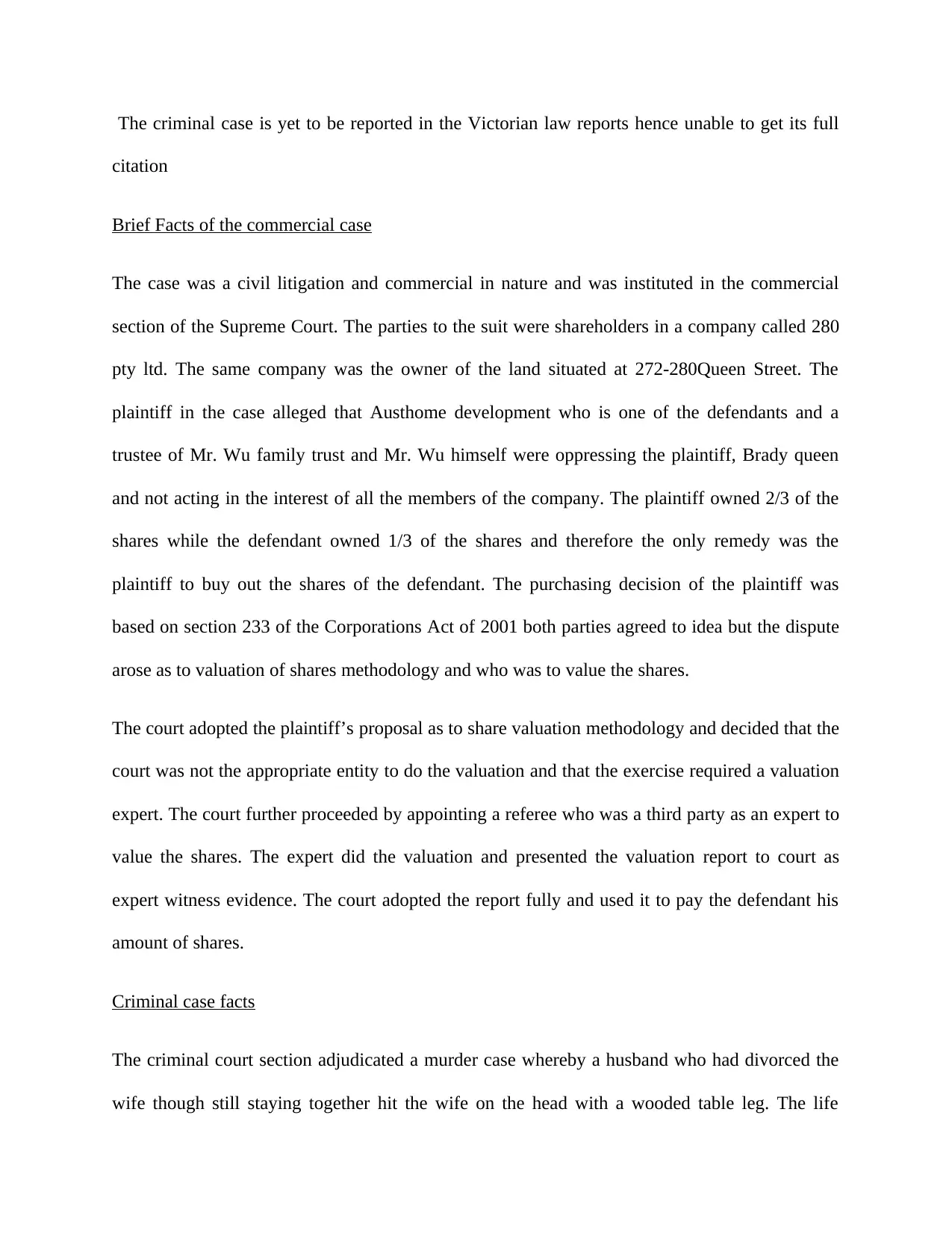
The criminal case is yet to be reported in the Victorian law reports hence unable to get its full
citation
Brief Facts of the commercial case
The case was a civil litigation and commercial in nature and was instituted in the commercial
section of the Supreme Court. The parties to the suit were shareholders in a company called 280
pty ltd. The same company was the owner of the land situated at 272-280Queen Street. The
plaintiff in the case alleged that Austhome development who is one of the defendants and a
trustee of Mr. Wu family trust and Mr. Wu himself were oppressing the plaintiff, Brady queen
and not acting in the interest of all the members of the company. The plaintiff owned 2/3 of the
shares while the defendant owned 1/3 of the shares and therefore the only remedy was the
plaintiff to buy out the shares of the defendant. The purchasing decision of the plaintiff was
based on section 233 of the Corporations Act of 2001 both parties agreed to idea but the dispute
arose as to valuation of shares methodology and who was to value the shares.
The court adopted the plaintiff’s proposal as to share valuation methodology and decided that the
court was not the appropriate entity to do the valuation and that the exercise required a valuation
expert. The court further proceeded by appointing a referee who was a third party as an expert to
value the shares. The expert did the valuation and presented the valuation report to court as
expert witness evidence. The court adopted the report fully and used it to pay the defendant his
amount of shares.
Criminal case facts
The criminal court section adjudicated a murder case whereby a husband who had divorced the
wife though still staying together hit the wife on the head with a wooded table leg. The life
citation
Brief Facts of the commercial case
The case was a civil litigation and commercial in nature and was instituted in the commercial
section of the Supreme Court. The parties to the suit were shareholders in a company called 280
pty ltd. The same company was the owner of the land situated at 272-280Queen Street. The
plaintiff in the case alleged that Austhome development who is one of the defendants and a
trustee of Mr. Wu family trust and Mr. Wu himself were oppressing the plaintiff, Brady queen
and not acting in the interest of all the members of the company. The plaintiff owned 2/3 of the
shares while the defendant owned 1/3 of the shares and therefore the only remedy was the
plaintiff to buy out the shares of the defendant. The purchasing decision of the plaintiff was
based on section 233 of the Corporations Act of 2001 both parties agreed to idea but the dispute
arose as to valuation of shares methodology and who was to value the shares.
The court adopted the plaintiff’s proposal as to share valuation methodology and decided that the
court was not the appropriate entity to do the valuation and that the exercise required a valuation
expert. The court further proceeded by appointing a referee who was a third party as an expert to
value the shares. The expert did the valuation and presented the valuation report to court as
expert witness evidence. The court adopted the report fully and used it to pay the defendant his
amount of shares.
Criminal case facts
The criminal court section adjudicated a murder case whereby a husband who had divorced the
wife though still staying together hit the wife on the head with a wooded table leg. The life
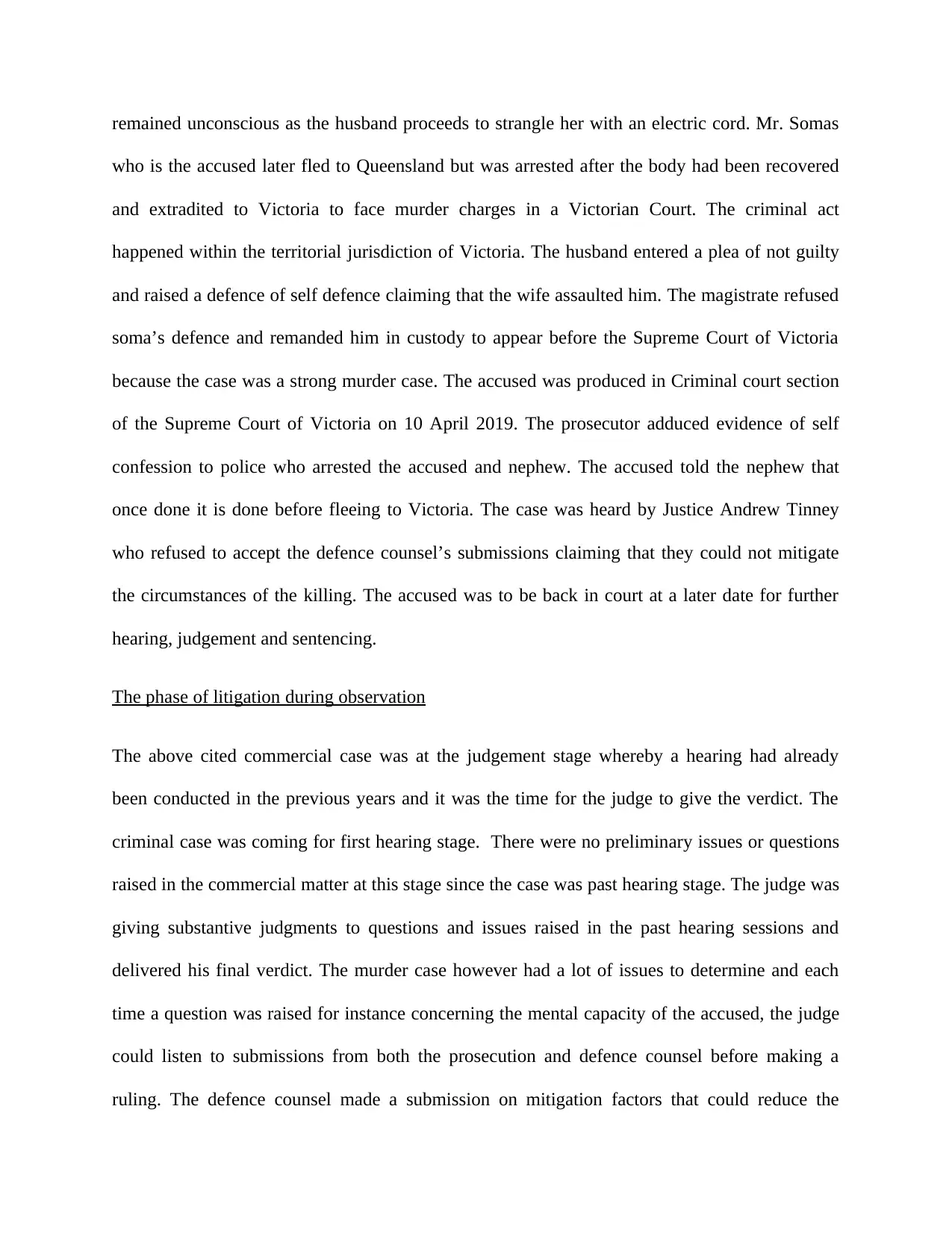
remained unconscious as the husband proceeds to strangle her with an electric cord. Mr. Somas
who is the accused later fled to Queensland but was arrested after the body had been recovered
and extradited to Victoria to face murder charges in a Victorian Court. The criminal act
happened within the territorial jurisdiction of Victoria. The husband entered a plea of not guilty
and raised a defence of self defence claiming that the wife assaulted him. The magistrate refused
soma’s defence and remanded him in custody to appear before the Supreme Court of Victoria
because the case was a strong murder case. The accused was produced in Criminal court section
of the Supreme Court of Victoria on 10 April 2019. The prosecutor adduced evidence of self
confession to police who arrested the accused and nephew. The accused told the nephew that
once done it is done before fleeing to Victoria. The case was heard by Justice Andrew Tinney
who refused to accept the defence counsel’s submissions claiming that they could not mitigate
the circumstances of the killing. The accused was to be back in court at a later date for further
hearing, judgement and sentencing.
The phase of litigation during observation
The above cited commercial case was at the judgement stage whereby a hearing had already
been conducted in the previous years and it was the time for the judge to give the verdict. The
criminal case was coming for first hearing stage. There were no preliminary issues or questions
raised in the commercial matter at this stage since the case was past hearing stage. The judge was
giving substantive judgments to questions and issues raised in the past hearing sessions and
delivered his final verdict. The murder case however had a lot of issues to determine and each
time a question was raised for instance concerning the mental capacity of the accused, the judge
could listen to submissions from both the prosecution and defence counsel before making a
ruling. The defence counsel made a submission on mitigation factors that could reduce the
who is the accused later fled to Queensland but was arrested after the body had been recovered
and extradited to Victoria to face murder charges in a Victorian Court. The criminal act
happened within the territorial jurisdiction of Victoria. The husband entered a plea of not guilty
and raised a defence of self defence claiming that the wife assaulted him. The magistrate refused
soma’s defence and remanded him in custody to appear before the Supreme Court of Victoria
because the case was a strong murder case. The accused was produced in Criminal court section
of the Supreme Court of Victoria on 10 April 2019. The prosecutor adduced evidence of self
confession to police who arrested the accused and nephew. The accused told the nephew that
once done it is done before fleeing to Victoria. The case was heard by Justice Andrew Tinney
who refused to accept the defence counsel’s submissions claiming that they could not mitigate
the circumstances of the killing. The accused was to be back in court at a later date for further
hearing, judgement and sentencing.
The phase of litigation during observation
The above cited commercial case was at the judgement stage whereby a hearing had already
been conducted in the previous years and it was the time for the judge to give the verdict. The
criminal case was coming for first hearing stage. There were no preliminary issues or questions
raised in the commercial matter at this stage since the case was past hearing stage. The judge was
giving substantive judgments to questions and issues raised in the past hearing sessions and
delivered his final verdict. The murder case however had a lot of issues to determine and each
time a question was raised for instance concerning the mental capacity of the accused, the judge
could listen to submissions from both the prosecution and defence counsel before making a
ruling. The defence counsel made a submission on mitigation factors that could reduce the
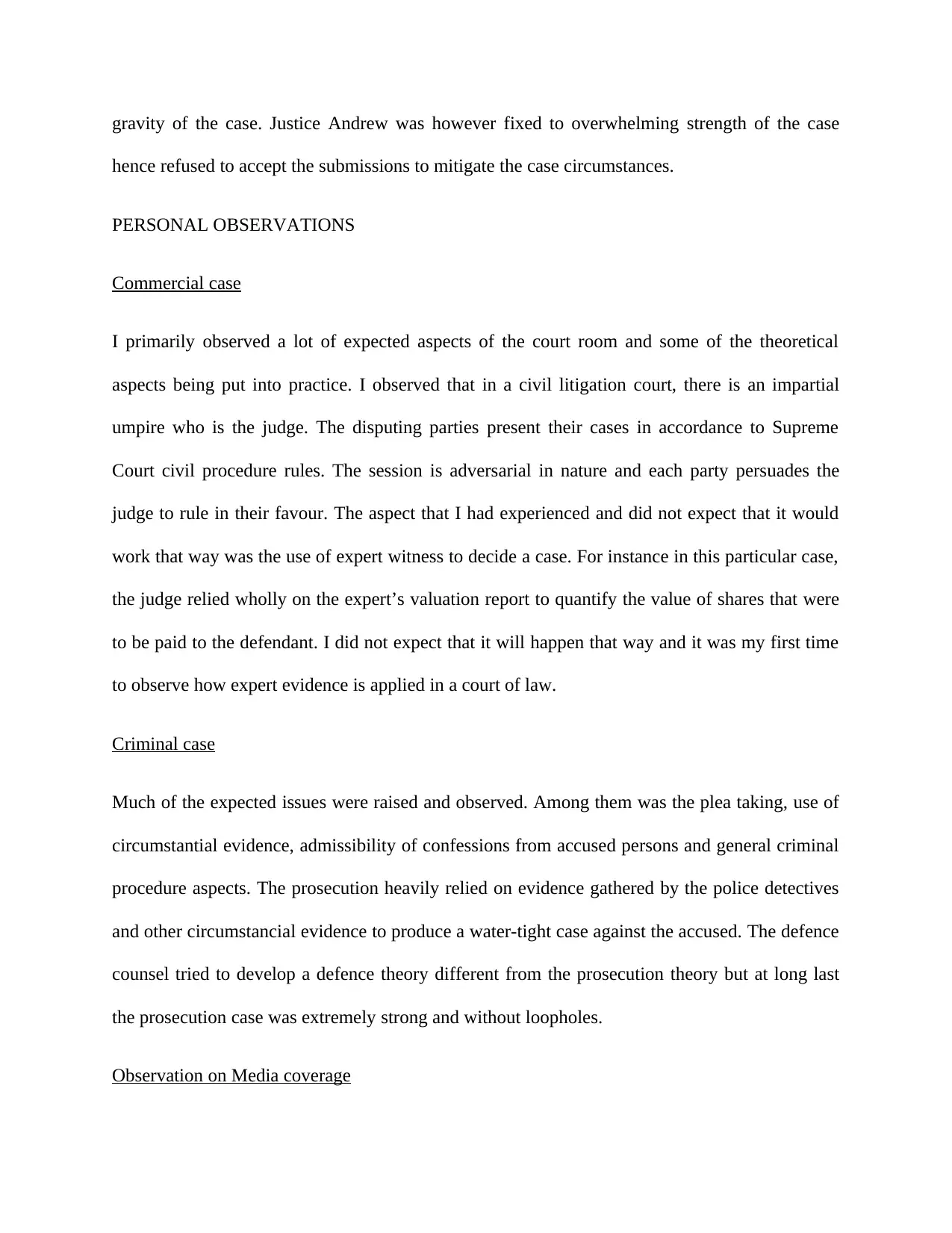
gravity of the case. Justice Andrew was however fixed to overwhelming strength of the case
hence refused to accept the submissions to mitigate the case circumstances.
PERSONAL OBSERVATIONS
Commercial case
I primarily observed a lot of expected aspects of the court room and some of the theoretical
aspects being put into practice. I observed that in a civil litigation court, there is an impartial
umpire who is the judge. The disputing parties present their cases in accordance to Supreme
Court civil procedure rules. The session is adversarial in nature and each party persuades the
judge to rule in their favour. The aspect that I had experienced and did not expect that it would
work that way was the use of expert witness to decide a case. For instance in this particular case,
the judge relied wholly on the expert’s valuation report to quantify the value of shares that were
to be paid to the defendant. I did not expect that it will happen that way and it was my first time
to observe how expert evidence is applied in a court of law.
Criminal case
Much of the expected issues were raised and observed. Among them was the plea taking, use of
circumstantial evidence, admissibility of confessions from accused persons and general criminal
procedure aspects. The prosecution heavily relied on evidence gathered by the police detectives
and other circumstancial evidence to produce a water-tight case against the accused. The defence
counsel tried to develop a defence theory different from the prosecution theory but at long last
the prosecution case was extremely strong and without loopholes.
Observation on Media coverage
hence refused to accept the submissions to mitigate the case circumstances.
PERSONAL OBSERVATIONS
Commercial case
I primarily observed a lot of expected aspects of the court room and some of the theoretical
aspects being put into practice. I observed that in a civil litigation court, there is an impartial
umpire who is the judge. The disputing parties present their cases in accordance to Supreme
Court civil procedure rules. The session is adversarial in nature and each party persuades the
judge to rule in their favour. The aspect that I had experienced and did not expect that it would
work that way was the use of expert witness to decide a case. For instance in this particular case,
the judge relied wholly on the expert’s valuation report to quantify the value of shares that were
to be paid to the defendant. I did not expect that it will happen that way and it was my first time
to observe how expert evidence is applied in a court of law.
Criminal case
Much of the expected issues were raised and observed. Among them was the plea taking, use of
circumstantial evidence, admissibility of confessions from accused persons and general criminal
procedure aspects. The prosecution heavily relied on evidence gathered by the police detectives
and other circumstancial evidence to produce a water-tight case against the accused. The defence
counsel tried to develop a defence theory different from the prosecution theory but at long last
the prosecution case was extremely strong and without loopholes.
Observation on Media coverage
Secure Best Marks with AI Grader
Need help grading? Try our AI Grader for instant feedback on your assignments.
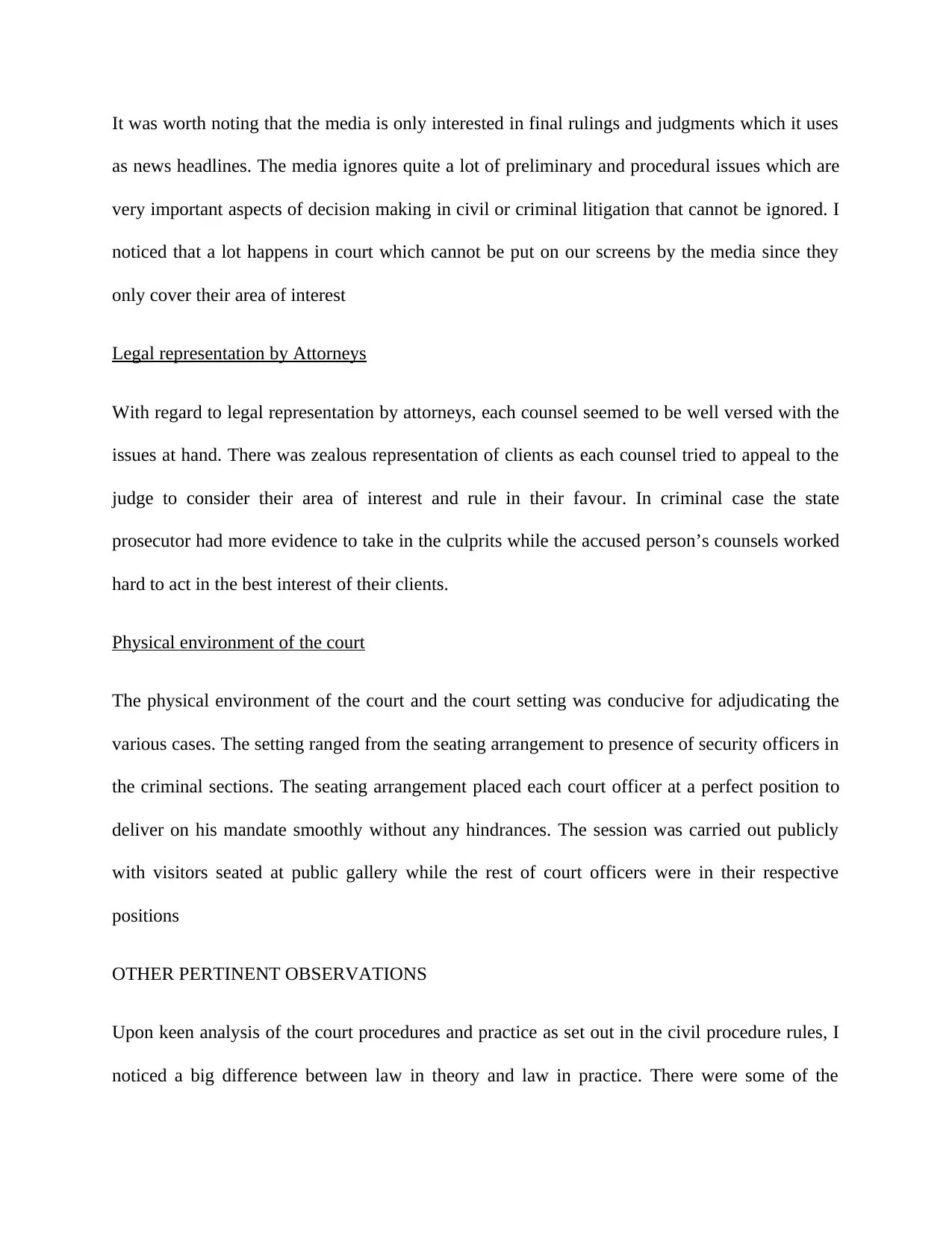
It was worth noting that the media is only interested in final rulings and judgments which it uses
as news headlines. The media ignores quite a lot of preliminary and procedural issues which are
very important aspects of decision making in civil or criminal litigation that cannot be ignored. I
noticed that a lot happens in court which cannot be put on our screens by the media since they
only cover their area of interest
Legal representation by Attorneys
With regard to legal representation by attorneys, each counsel seemed to be well versed with the
issues at hand. There was zealous representation of clients as each counsel tried to appeal to the
judge to consider their area of interest and rule in their favour. In criminal case the state
prosecutor had more evidence to take in the culprits while the accused person’s counsels worked
hard to act in the best interest of their clients.
Physical environment of the court
The physical environment of the court and the court setting was conducive for adjudicating the
various cases. The setting ranged from the seating arrangement to presence of security officers in
the criminal sections. The seating arrangement placed each court officer at a perfect position to
deliver on his mandate smoothly without any hindrances. The session was carried out publicly
with visitors seated at public gallery while the rest of court officers were in their respective
positions
OTHER PERTINENT OBSERVATIONS
Upon keen analysis of the court procedures and practice as set out in the civil procedure rules, I
noticed a big difference between law in theory and law in practice. There were some of the
as news headlines. The media ignores quite a lot of preliminary and procedural issues which are
very important aspects of decision making in civil or criminal litigation that cannot be ignored. I
noticed that a lot happens in court which cannot be put on our screens by the media since they
only cover their area of interest
Legal representation by Attorneys
With regard to legal representation by attorneys, each counsel seemed to be well versed with the
issues at hand. There was zealous representation of clients as each counsel tried to appeal to the
judge to consider their area of interest and rule in their favour. In criminal case the state
prosecutor had more evidence to take in the culprits while the accused person’s counsels worked
hard to act in the best interest of their clients.
Physical environment of the court
The physical environment of the court and the court setting was conducive for adjudicating the
various cases. The setting ranged from the seating arrangement to presence of security officers in
the criminal sections. The seating arrangement placed each court officer at a perfect position to
deliver on his mandate smoothly without any hindrances. The session was carried out publicly
with visitors seated at public gallery while the rest of court officers were in their respective
positions
OTHER PERTINENT OBSERVATIONS
Upon keen analysis of the court procedures and practice as set out in the civil procedure rules, I
noticed a big difference between law in theory and law in practice. There were some of the
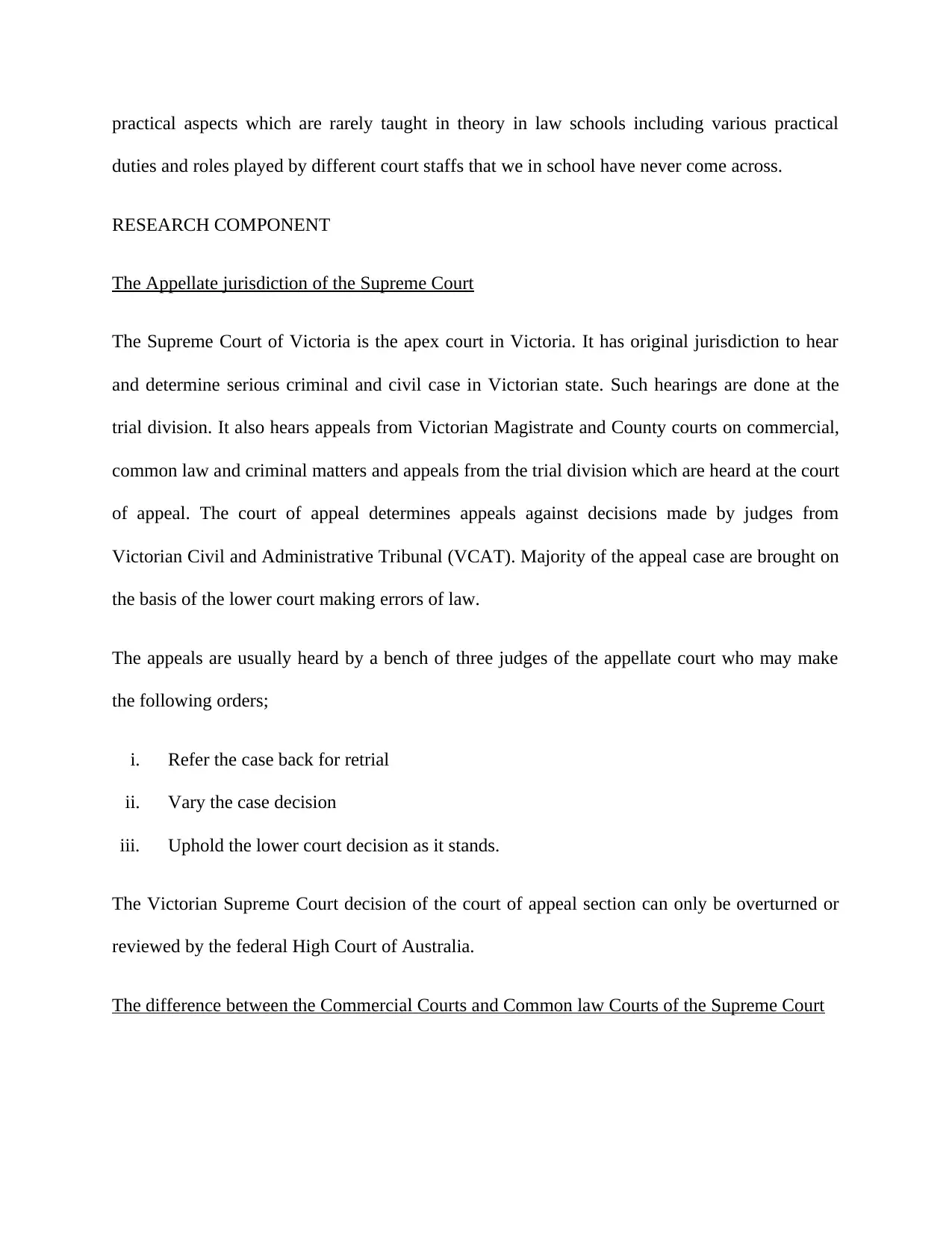
practical aspects which are rarely taught in theory in law schools including various practical
duties and roles played by different court staffs that we in school have never come across.
RESEARCH COMPONENT
The Appellate jurisdiction of the Supreme Court
The Supreme Court of Victoria is the apex court in Victoria. It has original jurisdiction to hear
and determine serious criminal and civil case in Victorian state. Such hearings are done at the
trial division. It also hears appeals from Victorian Magistrate and County courts on commercial,
common law and criminal matters and appeals from the trial division which are heard at the court
of appeal. The court of appeal determines appeals against decisions made by judges from
Victorian Civil and Administrative Tribunal (VCAT). Majority of the appeal case are brought on
the basis of the lower court making errors of law.
The appeals are usually heard by a bench of three judges of the appellate court who may make
the following orders;
i. Refer the case back for retrial
ii. Vary the case decision
iii. Uphold the lower court decision as it stands.
The Victorian Supreme Court decision of the court of appeal section can only be overturned or
reviewed by the federal High Court of Australia.
The difference between the Commercial Courts and Common law Courts of the Supreme Court
duties and roles played by different court staffs that we in school have never come across.
RESEARCH COMPONENT
The Appellate jurisdiction of the Supreme Court
The Supreme Court of Victoria is the apex court in Victoria. It has original jurisdiction to hear
and determine serious criminal and civil case in Victorian state. Such hearings are done at the
trial division. It also hears appeals from Victorian Magistrate and County courts on commercial,
common law and criminal matters and appeals from the trial division which are heard at the court
of appeal. The court of appeal determines appeals against decisions made by judges from
Victorian Civil and Administrative Tribunal (VCAT). Majority of the appeal case are brought on
the basis of the lower court making errors of law.
The appeals are usually heard by a bench of three judges of the appellate court who may make
the following orders;
i. Refer the case back for retrial
ii. Vary the case decision
iii. Uphold the lower court decision as it stands.
The Victorian Supreme Court decision of the court of appeal section can only be overturned or
reviewed by the federal High Court of Australia.
The difference between the Commercial Courts and Common law Courts of the Supreme Court
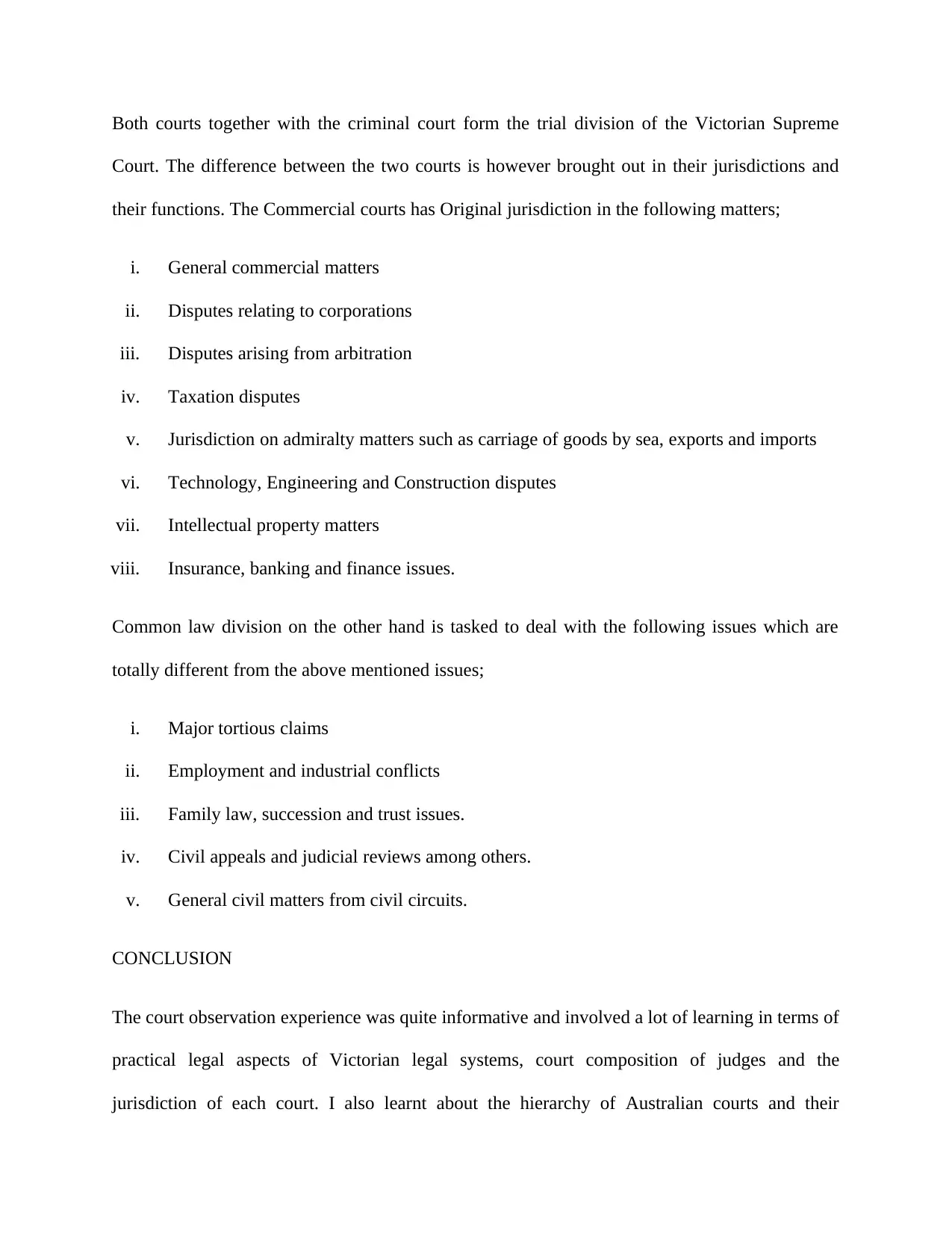
Both courts together with the criminal court form the trial division of the Victorian Supreme
Court. The difference between the two courts is however brought out in their jurisdictions and
their functions. The Commercial courts has Original jurisdiction in the following matters;
i. General commercial matters
ii. Disputes relating to corporations
iii. Disputes arising from arbitration
iv. Taxation disputes
v. Jurisdiction on admiralty matters such as carriage of goods by sea, exports and imports
vi. Technology, Engineering and Construction disputes
vii. Intellectual property matters
viii. Insurance, banking and finance issues.
Common law division on the other hand is tasked to deal with the following issues which are
totally different from the above mentioned issues;
i. Major tortious claims
ii. Employment and industrial conflicts
iii. Family law, succession and trust issues.
iv. Civil appeals and judicial reviews among others.
v. General civil matters from civil circuits.
CONCLUSION
The court observation experience was quite informative and involved a lot of learning in terms of
practical legal aspects of Victorian legal systems, court composition of judges and the
jurisdiction of each court. I also learnt about the hierarchy of Australian courts and their
Court. The difference between the two courts is however brought out in their jurisdictions and
their functions. The Commercial courts has Original jurisdiction in the following matters;
i. General commercial matters
ii. Disputes relating to corporations
iii. Disputes arising from arbitration
iv. Taxation disputes
v. Jurisdiction on admiralty matters such as carriage of goods by sea, exports and imports
vi. Technology, Engineering and Construction disputes
vii. Intellectual property matters
viii. Insurance, banking and finance issues.
Common law division on the other hand is tasked to deal with the following issues which are
totally different from the above mentioned issues;
i. Major tortious claims
ii. Employment and industrial conflicts
iii. Family law, succession and trust issues.
iv. Civil appeals and judicial reviews among others.
v. General civil matters from civil circuits.
CONCLUSION
The court observation experience was quite informative and involved a lot of learning in terms of
practical legal aspects of Victorian legal systems, court composition of judges and the
jurisdiction of each court. I also learnt about the hierarchy of Australian courts and their
Paraphrase This Document
Need a fresh take? Get an instant paraphrase of this document with our AI Paraphraser
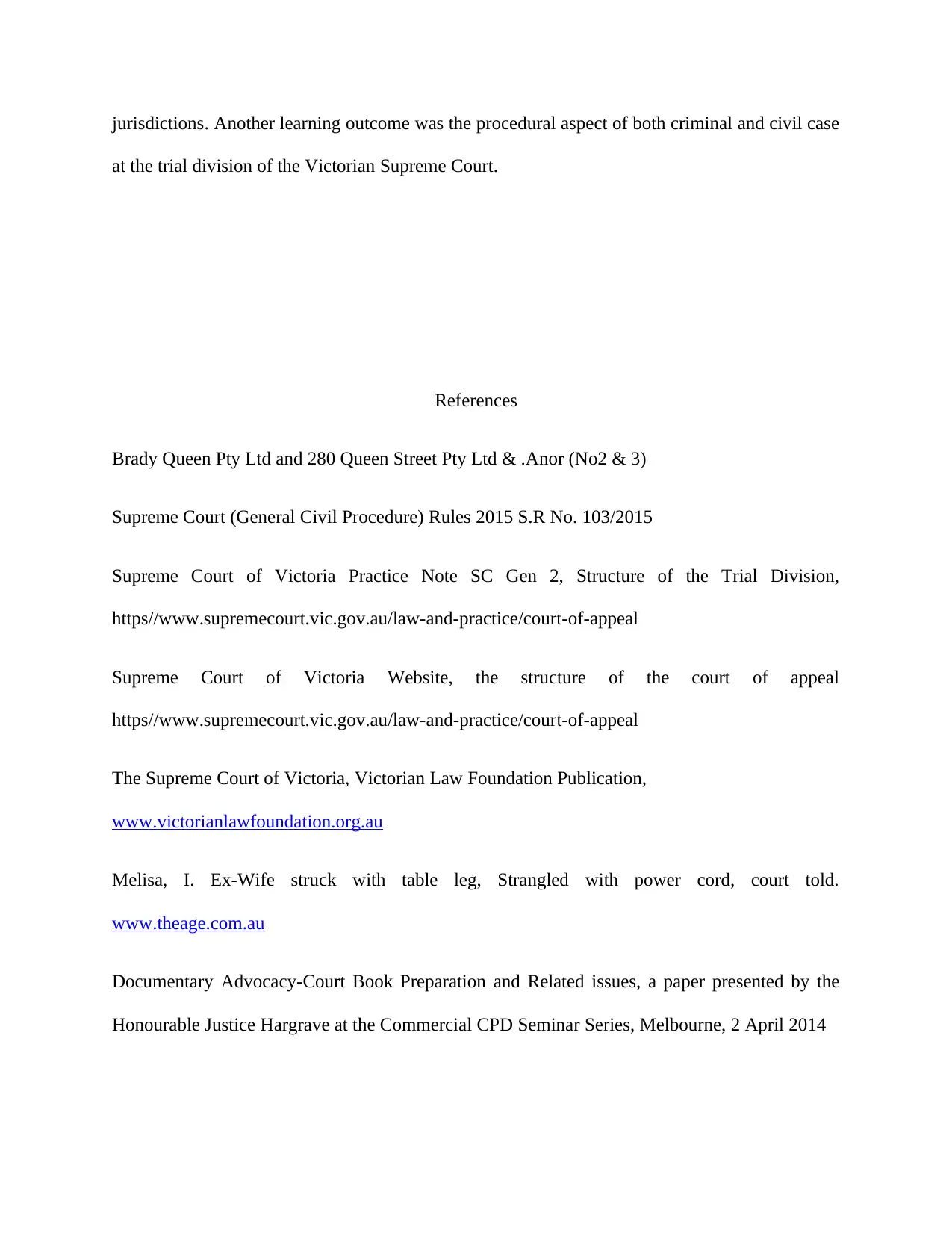
jurisdictions. Another learning outcome was the procedural aspect of both criminal and civil case
at the trial division of the Victorian Supreme Court.
References
Brady Queen Pty Ltd and 280 Queen Street Pty Ltd & .Anor (No2 & 3)
Supreme Court (General Civil Procedure) Rules 2015 S.R No. 103/2015
Supreme Court of Victoria Practice Note SC Gen 2, Structure of the Trial Division,
https//www.supremecourt.vic.gov.au/law-and-practice/court-of-appeal
Supreme Court of Victoria Website, the structure of the court of appeal
https//www.supremecourt.vic.gov.au/law-and-practice/court-of-appeal
The Supreme Court of Victoria, Victorian Law Foundation Publication,
www.victorianlawfoundation.org.au
Melisa, I. Ex-Wife struck with table leg, Strangled with power cord, court told.
www.theage.com.au
Documentary Advocacy-Court Book Preparation and Related issues, a paper presented by the
Honourable Justice Hargrave at the Commercial CPD Seminar Series, Melbourne, 2 April 2014
at the trial division of the Victorian Supreme Court.
References
Brady Queen Pty Ltd and 280 Queen Street Pty Ltd & .Anor (No2 & 3)
Supreme Court (General Civil Procedure) Rules 2015 S.R No. 103/2015
Supreme Court of Victoria Practice Note SC Gen 2, Structure of the Trial Division,
https//www.supremecourt.vic.gov.au/law-and-practice/court-of-appeal
Supreme Court of Victoria Website, the structure of the court of appeal
https//www.supremecourt.vic.gov.au/law-and-practice/court-of-appeal
The Supreme Court of Victoria, Victorian Law Foundation Publication,
www.victorianlawfoundation.org.au
Melisa, I. Ex-Wife struck with table leg, Strangled with power cord, court told.
www.theage.com.au
Documentary Advocacy-Court Book Preparation and Related issues, a paper presented by the
Honourable Justice Hargrave at the Commercial CPD Seminar Series, Melbourne, 2 April 2014
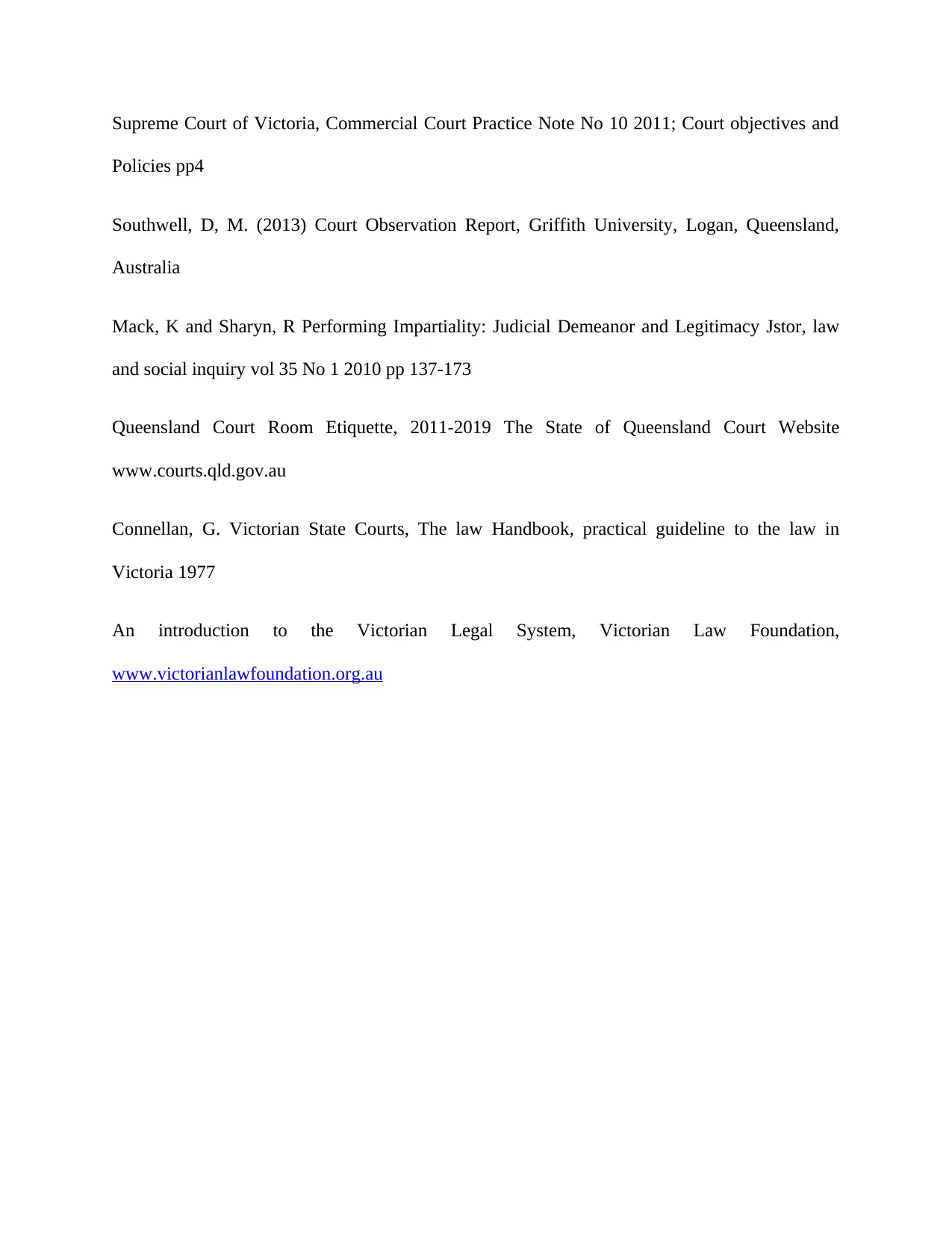
Supreme Court of Victoria, Commercial Court Practice Note No 10 2011; Court objectives and
Policies pp4
Southwell, D, M. (2013) Court Observation Report, Griffith University, Logan, Queensland,
Australia
Mack, K and Sharyn, R Performing Impartiality: Judicial Demeanor and Legitimacy Jstor, law
and social inquiry vol 35 No 1 2010 pp 137-173
Queensland Court Room Etiquette, 2011-2019 The State of Queensland Court Website
www.courts.qld.gov.au
Connellan, G. Victorian State Courts, The law Handbook, practical guideline to the law in
Victoria 1977
An introduction to the Victorian Legal System, Victorian Law Foundation,
www.victorianlawfoundation.org.au
Policies pp4
Southwell, D, M. (2013) Court Observation Report, Griffith University, Logan, Queensland,
Australia
Mack, K and Sharyn, R Performing Impartiality: Judicial Demeanor and Legitimacy Jstor, law
and social inquiry vol 35 No 1 2010 pp 137-173
Queensland Court Room Etiquette, 2011-2019 The State of Queensland Court Website
www.courts.qld.gov.au
Connellan, G. Victorian State Courts, The law Handbook, practical guideline to the law in
Victoria 1977
An introduction to the Victorian Legal System, Victorian Law Foundation,
www.victorianlawfoundation.org.au
1 out of 9
Your All-in-One AI-Powered Toolkit for Academic Success.
+13062052269
info@desklib.com
Available 24*7 on WhatsApp / Email
![[object Object]](/_next/static/media/star-bottom.7253800d.svg)
Unlock your academic potential
© 2024 | Zucol Services PVT LTD | All rights reserved.

